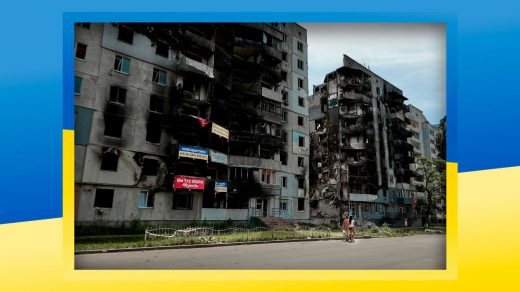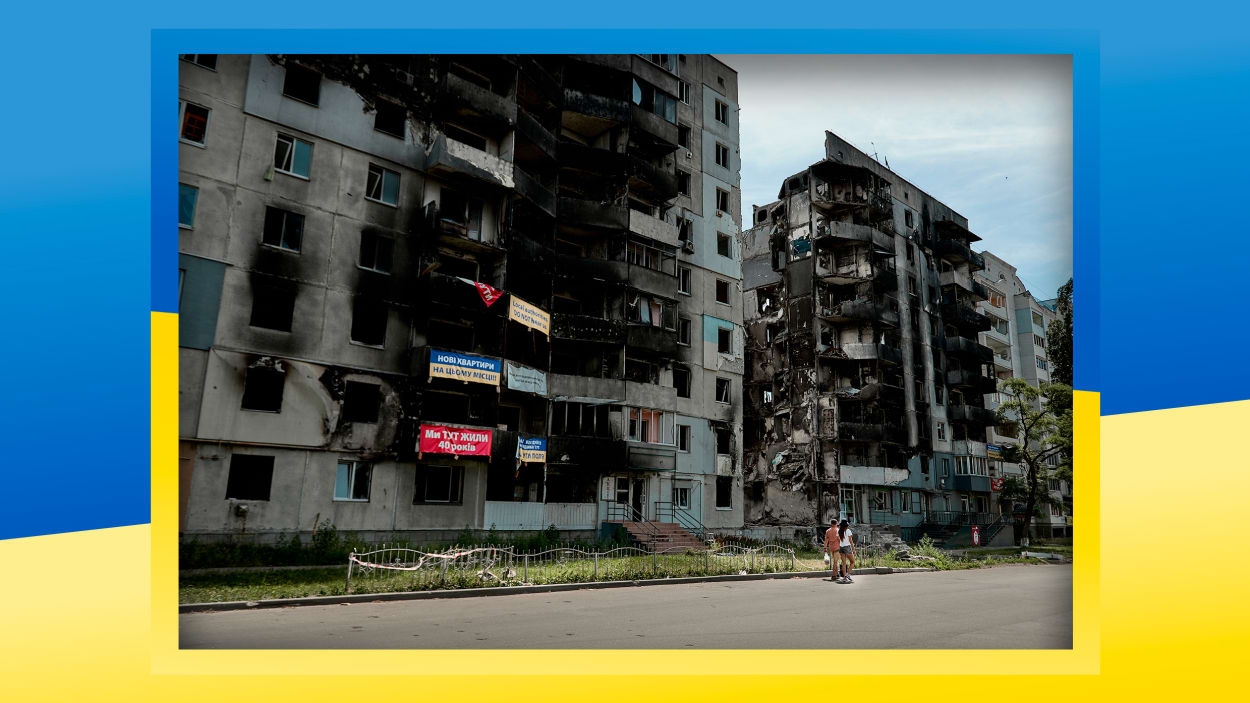To rebuild Ukraine for the future, architects are looking to the past
Modern warfare has dealt severe blows to cities around the world. In centuries past, armored troops faced off in open fields and, though cities were pillaged, people rarely saw combat on the streets. In recent decades, however, history has presented us with a heartbreaking number of cases where cities have been reduced to battlegrounds, and the stakes have risen far beyond the loss of human lives.
Almost a year ago to this day, Mariupol, Kharkiv, Kyiv, and many other Ukrainian cities were met with this fate, when Russian troops began their attack on the country. Since then, large swaths of Ukraine have been reduced to rubble, and for myriad architects across the country, the urge to rebuild has become the project of their lifetime. But who should lead those rebuilding efforts—and who should not? What will post-war Ukraine look like? And when so much of the country has been demolished, what should be rebuilt first?
For better or worse, history has a tendency to repeat itself, and far too many cities have asked themselves those same questions in the past. Some of the answers they came up with worked in their favor, but many of them—served up too fast, or by the wrong decision-makers—spawned a brand-new set of questions, each more complex than the rest. If Ukraine looks to the past for answers, it probably won’t find a clear path to follow; Kyiv isn’t the same as Beirut or London or Hiroshima, after all. But it may find a helpful assortment of examples and shape them into lessons of its own.
This is why Anna Kyrii embarked on something she calls a “world case study.” The Kyiv-based architect runs her own practice, Kyrii Group, and is also the head of the Foundation of Ukrainian Architectural Chamber. In collaboration with Pro Pm, a school for construction project management, Kyrii’s team has led a thorough investigation into how cities have rebuilt after war and conflict. Working with experts (including history professors, urban planners, and architects) across 12 cities including Rotterdam, Dresden, Hiroshima, Beirut, and London, Kyrii and her team want to equip decision makers with practical tools for rebuilding. “When you start a huge project, you should do research,” Kyrii says.
Who gets to decide?
One of the cities the researchers put under their microscope was Beirut. Before a civil war erupted in 1975 (in part due to tensions among Lebanon’s Christian and Muslim populations), Beirut was known as “Paris of the East” for how its Arab motifs intermixed with more Western influences. According to Lilet Breddels, an Amsterdam-based researcher and editor who has studied the reconstruction of Beirut for more than 20 years and is now working on rebuilding Ukraine with a local “urban coalition” called Ro3kvit, those who coined that nickname may have been a little too chivalrous with the compliment. “Most built environment consisted of old, not that well-built houses with huge density and poor circumstances,” she says.
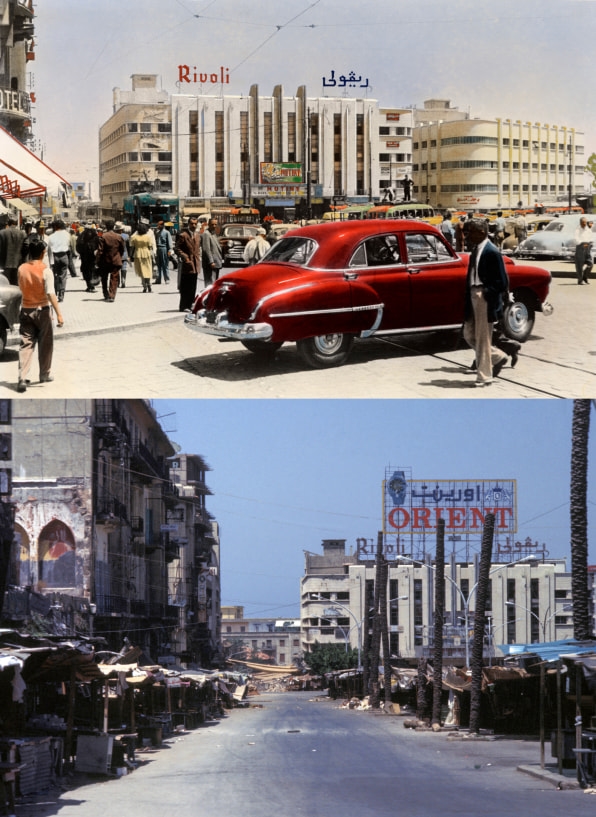
When Beirut finally emerged from the civil war in 1990, the city was in shambles. To this day, the bullet-ridden, empty husk of the Holiday Inn hotel stands as a symbol of the city’s brutal war. Almost immediately, city authorities set out to restore Beirut to its former self. The problem, says Breddels, is they were so focused on the idea of building a new “Paris of the East” that they ignored the challenges of how they might practically and affordably do so.
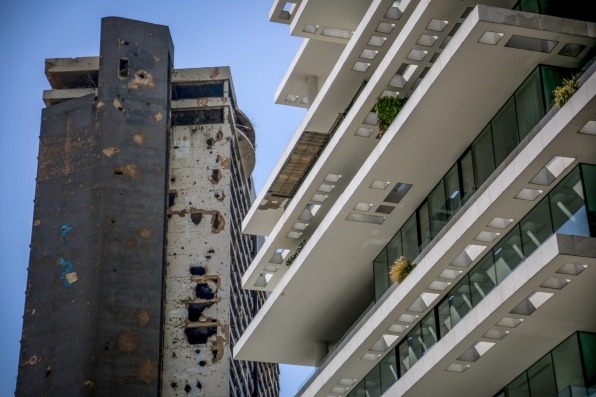
The misalignment, Breddels says, is somewhat easy to explain with a short history. When Beirut set out to rebuild, Lebanon’s then prime minister, Rafic Hariri, led the reconstruction efforts. Hariri, a billionaire, was also a shareholder of Solidere, a public-private company that the government tapped to rebuild the centre of Beirut. “A company wants to make money,” Breddels says. The government purchased most of the city centre, Solidere got the contract, and subsequently wiped away many architectural gems from a bygone era before erecting new buildings no one could afford to live in. Eventually, they also turned parts of the Green Line—a wide avenue that separated the mostly Muslim factions in West Beirut from the predominantly Christian East Beirut—into an even wider highway. “They didn’t know what to do,” says Breddels, noting they could’ve built a commemorative park instead.
This kind of top-down approach is becoming increasingly rare as more government officials adopt citizen input, but many Ukrainian architects are concerned their country may be headed in the same direction as Beirut. The problem lies in a contentious urban planning reform, known as Bill No. 5655, which critics believe would put developers in charge of much of Ukraine’s rebuilding with little consideration for citizen’s opinions. Despite two long years of opposition from the local architecture community, which feared it could lead to a monopolized market, the bill was adopted on December 13. Immediately after, Kyrii and 25,000 other people signed a petition demanding that Zelensky veto the law, but the outcome remains unclear.
The bill raises important questions about power and who gets to wield it when cities are left in ruins. For Breddels, the key is a tiered approach to decision-making. First, the government should lay out “the rules of the games” (e.g., architects should have a seat at the table, citizens should be involved in every step of the process, etc.). Then, local authorities get to create their own set of sub-rules.
Sometimes, these rules materialize as masterplans, or city-wide visions like the one Norman Foster is currently developing for the city of Kharkiv in Ukraine. But by their very nature, plans can constrain war-torn cities and force them to grow in a certain direction over another. “I don’t believe in laying out a plan that’s set in stone,” says Breddels. “Having ideas of zones, mobility, that should be planned but not too fixed, it should grow more organically.”
The perils of planning
In the face of so many unknowns, Breddels argues that overdeveloped masterplans could hinder progress. Great Britain provides a pertinent example of this dynamic. At the end of World War II, the country was ravaged after eight months of sustained aerial bombing attacks carried out by the Luftwaffe, the German Air Force. London had suffered the most by the so-called Blitz: One out of six Londoners was homeless at some point during it. But other cities like Coventry, Liverpool, and Birmingham were significantly affected as well.
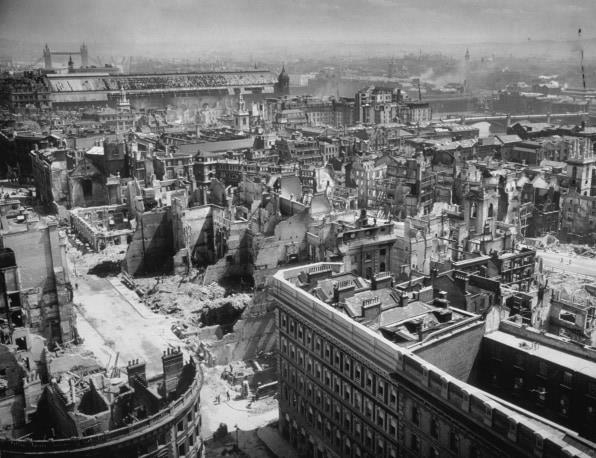
Soon after the Blitz ended in 1941, the British government hired the illustrious planner Patrick Abercrombie to develop what became known as the Greater London Plan. Commissioned in 1942 and published in 1944, the plan sought to redistribute London’s population—which had been packed into unsafe, insalubrious maze of Victorian and Georgian-era rabbit warren streets—into dozens of “New Towns” built on the fringes of the historic center. It also called for a “Green Belt” of parks and recreational spaces encircling the city. The plan was displayed in museums and admired by the King and Queen, but only parts of it were built. It also wasn’t the only proposal—far from it.
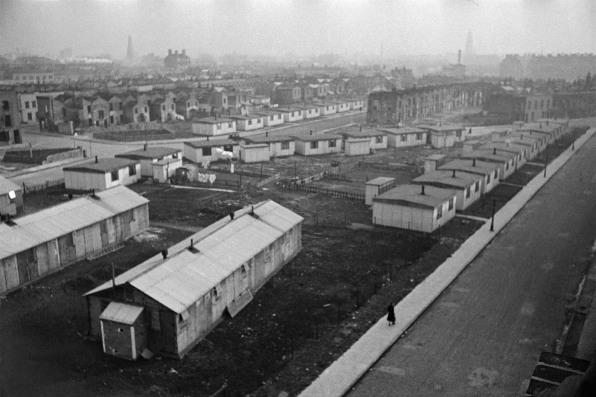
According to Peter Larkham, a professor of planning at Birmingham City University who was also involved in the world case study project for Ukraine, at least 250 plans were drawn up between the ’40s and the ’60s, though it is impossible to know how many of them came to fruition. Great Britain effectively became a Russian doll of plans that trickled down from region, to county, to city, and to boroughs. “Some of them worked together and some were contradicting,” says Larkham. And London’s regional plan, which should have been drafted first, was drafted last.
Then, in 1947, the British Parliament introduced the Town and Country Planning Act. The goal of the act was to create a more orderly and planned approach to urban and rural development, but in the process, Larkham says it rendered all previous plans unusable, and established a new set of criteria for how new plans should look. “[City authorities] got the best artists to produce the visualizations of the new city, and they never quite built what those visuals looked like,” says Larkham of the flurry of plans that had come before the 1947 legislation.
Part of the issue is that Great Britain was bankrupt at the end of the war. Food and building materials were rationed until 1954. And by the time the economy recovered and the country was ready to act on the various plans that had been drafted, 10 to 15 years had passed and ideas had changed. But there’s a reason why so many cities scrambled to have their own plan, says Larkham. Cities were competing for finite resources and plans were a bargaining tool for funds. “If you have a plan, you can wave it to people and something might happen,” he says in jest. “If you don’t have a plan, what happens?”
While waiting for funds, the city built temporary structures and prefab housing “on every bit of scrap and bomb land you could find,” says Larkham. Some bomb sites became “adventure” playgrounds or grounds for improvised cricket matches; others were cleared and leased as parking lots. Eventually, London did begin to implement some ideas from the Greater London Plan, which had been altered several times by the time funds became available. The most popular of them—and perhaps the most talked-about piece of British planning legislation in the country’s history—remains the Green Belt, with more than one million acres of greenery encircling the city. According to Larkham, the other biggest “survivors” of the plan were lower density in the heart of the city, land-use zoning to prevent polluting industries from coexisting with housing, and “neighborhood units” for new residential areas. “Most weren’t new ideas, but the bomb damage gave opportunity for large-scale planning and so these ideas became plans and came to be ingrained in planners’ and architects’ consciousness into the 1970s,” he says.
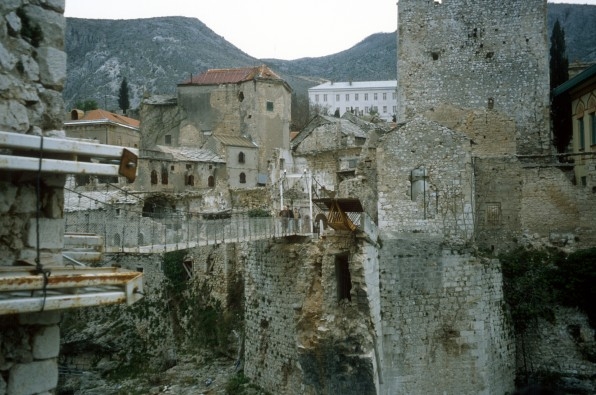
There are many lessons to learn from London’s approach, and the most fundamental of them is also the most difficult to accept: Rebuilding takes time, and time necessitates setting priorities. At the end of the war in Bosnia and Herzegovina in 1995, one of the first things the city of Mostar rebuilt was a 16th-century limestone bridge known as Stari Most (Old Bridge) to symbolize reconciliation. In Great Britain, the sheer devastation brought on by the Blitz meant that housing, particularly high-rises, became a top priority for London’s growing population, and by the 1960s, more than half a million new apartments had been built, many of them in tower blocks.
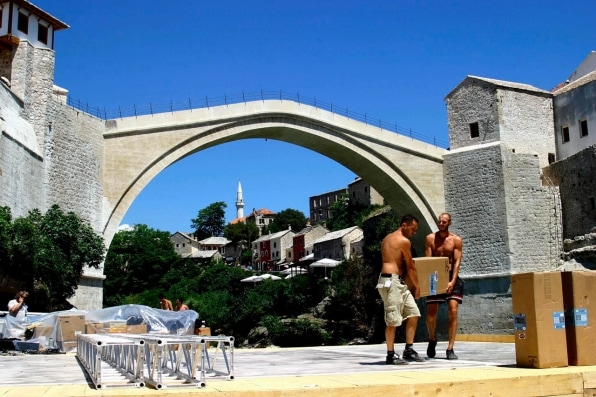
To a certain degree, a “housing-first” approach makes sense in Ukraine, too. Already, various architects have focused on building or rebuilding homes for internally displaced people. In Bucha, outside of Kyiv, the Ukrainian firm Balbek Bureau is working on a pilot project for a series of housing projects. In Ivano-Frankivsk, a local NGO called Metalab has been converting abandoned dorms and kindergartens into co-housing developments. But not every city has followed the same logic.
First things first
On August 6, 1945, at 8:15 a.m., the U.S. dropped the first atomic bomb in history over Hiroshima, in Japan. The explosion killed 80,000 people instantly, and another 60,000 by the end of the year. It razed, burnt, or partially destroyed around 90% of buildings in the city, and that’s on top of the 10,000 or so houses that had already been torn down to make way for open spaces known as “firebreaks” in preparation for what Japan expected to be an air raid. (Most buildings were made of wood.)
The sheer devastation demanded a complete reinvention, or a grand vision, for what the city could look like after the war. But the very concept of a “vision” doesn’t exist in Japanese. Carola Hein is a professor of architecture and urban planning history at the Delft University of Technology in The Netherlands, who has spent many years living in Japan and studying its post-war reconstruction.
She explains that comprehensive masterplans, or idealistic visions, were foreign to the Japanese way of thinking. So when Japanese cities, 215 of which had been bombed, set out to rebuild, they did what they knew best—namely focusing on pragmatic infrastructural improvements like widening and straightening roads to modernize and facilitate the movement of people, goods, and basic services like fire engines. Known as land readjustment (kukakuseiri) these planning technique included regulating the number of individual building sites along any given road. But beyond that, reconstructing housing was mostly left to private landowners.
The argument behind wider streets was rooted in pragmatism and the fact that ultra-dense, haphazardly built cities simply aren’t safe when war, fires, or natural disasters strike. Unlike Beirut, where wide streets evoked grandeur and recalled Haussmann’s Parisian avenues, Japan’s plan wasn’t following anyone’s ego. It wasn’t allowed to, says Hein, adding that the Allied Powers occupied Japan for seven years after the bomb dropped, ushering the end of WWII and the start of the Cold War. Japanese authorities even had to get permission from the Allies to rebuild.
Japan’s rebuilding was largely rooted in pragmatism, but there was one exception to the rule, and that was architect Kenzo Tange’s proposal for Hiroshima. Tange would go on to become one of Japan’s most honored architects but, at the time, he was one of many dispatched by the Japanese government to do research in Hiroshima. Some years later, the city held a design competition soliciting ideas for Hiroshima as a “city of peace.” Tange proposed—and ended up building—a plan that included Peace Memorial Park, right where the bomb had dropped, as well as a 330-foot wide Peace Boulevard, and the Hiroshima Peace Center, that featured an arch where visitors could peek through and see the remnants of the A-bomb Dome, one of few concrete structures still standing after the bomb exploded.
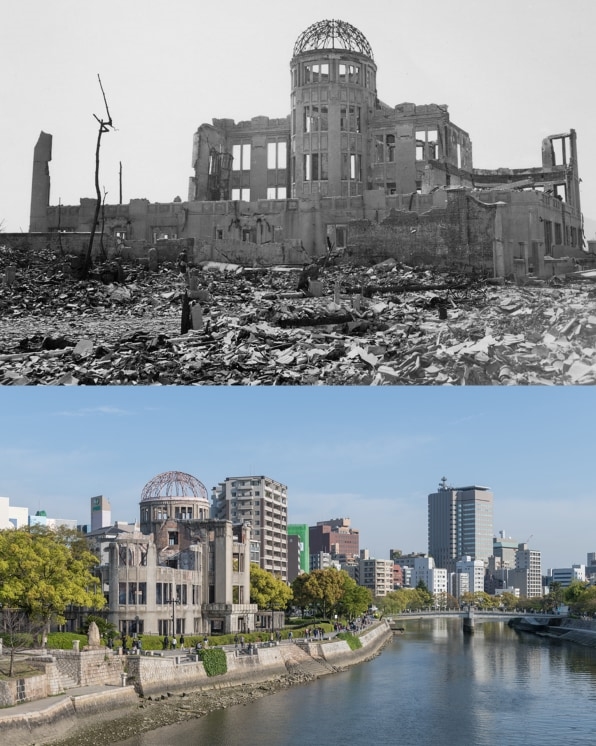
The A-bomb Dome, known as Genbaku Dome, became a Unesco world heritage site in 1966, and is now a powerful memorial to the people who were killed. For Kyrii, the architect from Kyiv, Ukraine could take a similar approach with some of its ruins. “We should leave some buildings destroyed like a monument to show the next generation what Russkiy Mir looks like,” she says of a phrase that translates as “Russian world” or “Russian peace” and has driven the Kremlin’s foreign policy for years. “For the next generation, the message should be: If you want to see what Russian World looks like, please see this destroyed building.”
Ultimately, there’s something to be learned from each of these cities, even if those lessons end up being nothing more than cautionary tales. A year into the war, the fate of Ukraine remains unclear, but for Kyrii, one thing is clear: Citizens should be involved every step of the way. “If communities want to create new cities like Rotterdam, it should be their decision, not Anna Kyrii or superstar architects,” she says. “It should be decided by local communities.”
If this thought sounds like a broken record, that’s because it has been rehashed by anguished architects and urban planners for decades. As Ukraine enters its second year of war, the prospect of peace—or victory, as many Ukrainians view it—remains as murky as ever. But if history has taught us anything, it is that, as the Spanish writer-philosopher George Santayana wrote over a century ago, “those who cannot remember the past are condemned to repeat it.”
(15)

